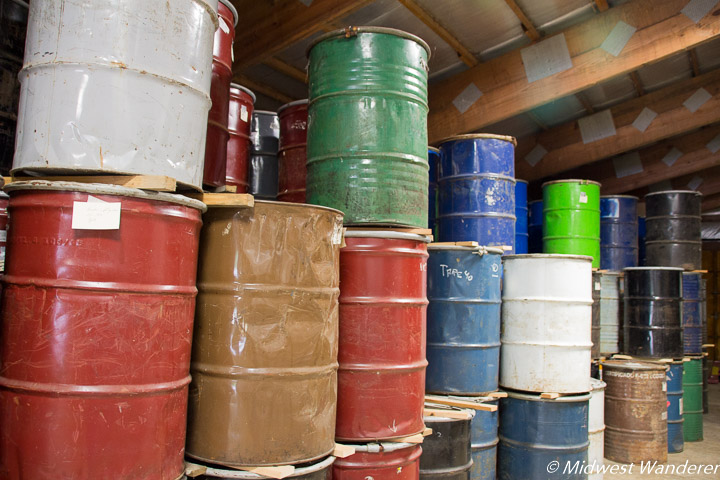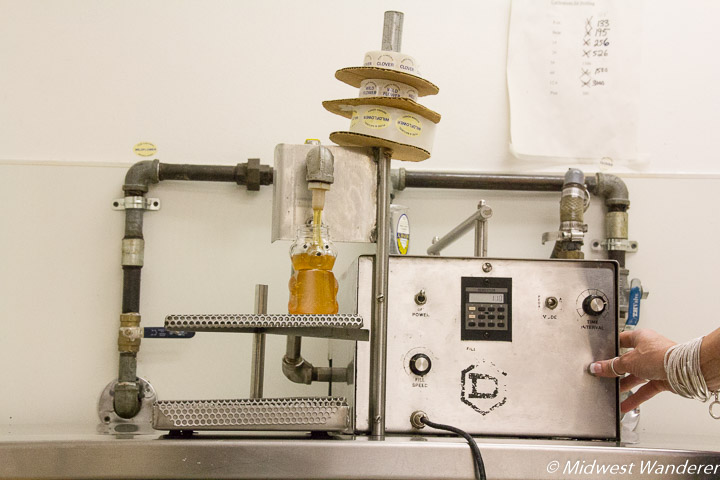Not being a farm girl, I always thought beehives on bee farms were the natural ones. You know, the kind that Winnie the Pooh tries to steal honey from. Was I ever wrong, as I found out when I took the Honey Barn Tour at Hunter’s Honey Farm in Martinsville, Indiana.Beekeepers use man-made hives that look like this:
I learned a lot more, too, on the tour, including some bee biology, how the hives work and how honey and beeswax is harvested.
A lesson on bee biology
On the first part of the hour-long tour, our guide, Jody, started with some fascinating facts about honey bees. For instance, you may have known that when a honey bee stings you, it dies. But did you know that it’s because it is the only stinging insect whose stinger is barbed? When it comes out of the bee and sticks into your skin, part of the bee’s intestine is pulled out with it.
Jody was full of tidbits of information like this. We also learned that there is one queen bee per hive, 100 to 400 drones (male bees whose sole purpose is to breed with the queen), and from 40,000 to 80,000 female worker bees. The worker bees each have their own function, too. They may be a forager that collects nectar and pollen; a guard that keeps intruders away from the hive, a housekeeper that builds the comb, repairs it and keeps it clean; or a nurse that cares for the queen, the drones and the larvae, including feeding and cleaning them.
About the hives
The hives are made up of several sections, including the reducer from which the bees fly in and out, the brood area, and the top most section called the super. The super holds frames on which the bees build combs for storing honey.
 Pollen is also collected in the hive. As bees enter flowers to collect the nectar, pollen is picked up in their fur. They clean the pollen off of themselves by packing it an area on their legs. When they re-enter the hive, the pollen is collected in a screened box.
Pollen is also collected in the hive. As bees enter flowers to collect the nectar, pollen is picked up in their fur. They clean the pollen off of themselves by packing it an area on their legs. When they re-enter the hive, the pollen is collected in a screened box.
Don’t miss a Midwest Wanderer post. For a FREE subscription, enter your e-mail address in the Subscribe2 box to the right and click Subscribe.
So if there are guards at the hive, how does a beekeeper access the hive? They use a smoker like this:
 Filled with twigs, leaves and other natural things found on the forest floor, they light it and then blow the smoke at the hive with the bellow. The smoke throws off the guard bees’ sense of scent, and since bees communicate by scent, it throws off their communication. This lessens the chance that the beekeeper will be stung when working with the bees.
Filled with twigs, leaves and other natural things found on the forest floor, they light it and then blow the smoke at the hive with the bellow. The smoke throws off the guard bees’ sense of scent, and since bees communicate by scent, it throws off their communication. This lessens the chance that the beekeeper will be stung when working with the bees.
The harvest
Bees produce five products: honey, of course, but also beeswax, pollen, royal jelly and propolis. Harvest usually begins by the end of June and continues through August, which is the biggest harvest month. The supers, where the honey is stored, are removed from the hive. The beekeeper uses a blower, similar to a leaf blower, to blow the bees off of the super, and transports the supers to the building for harvest.
Jody showed us the machinery that is used to separate the honey from the wax and explained how the wax is later melted, and the honey, depending on the time of the harvest, either goes directly into barrels or is pumped through a clarifier tank into a settling tank.
 Each hive produces about 60 pounds of honey during a season, and Hunter’s has about 500 hives. Honey is stored in barrels that hold 700 pounds each. We had seen the barrels on our way in. That’s a lot of honey!
Each hive produces about 60 pounds of honey during a season, and Hunter’s has about 500 hives. Honey is stored in barrels that hold 700 pounds each. We had seen the barrels on our way in. That’s a lot of honey!
 On the tour we saw a tank that reliquifies honey that has crystalized and other equipment to prepare the honey for market. An electric belt around a barrel also reliquifies the honey.
On the tour we saw a tank that reliquifies honey that has crystalized and other equipment to prepare the honey for market. An electric belt around a barrel also reliquifies the honey.
 Jody also showed us the bottling process. The bottling machine is calibrated to fill a bottle with a specific amount of honey. On the Honey Barn Tour, visitors have the opportunity to fill their own bottle.
Jody also showed us the bottling process. The bottling machine is calibrated to fill a bottle with a specific amount of honey. On the Honey Barn Tour, visitors have the opportunity to fill their own bottle.
Mind your beeswax
Beeswax is turned into candles, skincare products or sold simply as bars of beeswax. Hunter’s Honey Farm makes their own lip balm and molds candles and beeswax bars, Jody mentioned that beeswax candles burn very, very clean because there are no petroleum products in them, and although they are unscented, they remove other odors from a room.
 I loved this candle in the shape of a honey bear.
I loved this candle in the shape of a honey bear.
 Besides molded candles, Hunter’s Honey Farm makes rolled candles. Visitors on certain tours are allowed to roll their own candle.
Besides molded candles, Hunter’s Honey Farm makes rolled candles. Visitors on certain tours are allowed to roll their own candle.
The shop and observation hive
Hunter’s Honey Farm carries all things honey, including honey in various forms, pollen (often used for allergy relief), sauces made with honey, skincare products, candy and cookbooks.
 Also in the shop is an observation hive where you can watch the bees in action.
Also in the shop is an observation hive where you can watch the bees in action.
More about Hunter’s Honey Farm
- Hunter’s Honey Farm has been in business for over 100 years. Current owners, Tracy and Chris Hunter, are third-generation school teachers/beekeepers, and they are grooming a fourth generation.
- Hunter’s offers several different tours, which appeal to various demographics and interests. The Worker Special, which includes the barn tour, bottle your own honey and roll your own candle, is the most popular.
- Tours are usually conducted at 10 am., 1 p.m. and 3 p.m. and can be done for two people or up to one hundred. However, reservations are required in order for them to plan.
- Hunter’s Honey Farm is located at 6501 W Honey Lane in Martinsville, Indiana, about 30 miles southwest of Indianapolis. Visit the website for further details about the shop, products and tours.
Disclosures: Our visit to Hunter’s Honey Farm was part of a press trip hosted by Visit Hendricks County. Our tour was complimentary; however, any opinions expressed in this article are my own.
**********
Thank you for reading Midwest Wanderer. Don’t miss a post. Enter your e-mail address below and click Subscribe to be notified whenever I publish another post. Subscription is FREE. After subscribing, be sure to click the link when you get the e-mail asking you to confirm. – Connie







It is an amazing process weather on a large scale like this for a hobby for some. My dad makes honey and has been doing so for the last 20 odd years usually just about 6 drums a year or so but he loves it. It is a great occupation for some. I have helped my dad out a few times with the extraction of the honey. It is a very time-consuming profession.
Six drums a year is still a lot when you think that each drum holds 700 pounds of honey. I can imagine how much time it takes to process it.
It seems like a quite specialized little factory 😉
I love certain types of honey and I always have it at home.
What types of honey do you like, Monika?
Just reading about this is fascinating; I can only imagine how cool it was to see all this in person! I’d love to taste some of that honey (I always buy flavored honey as a souvenir when leaving Washington state) and buy some interesting new skincare! Thanks for the post. 🙂
Learning about bees and honey farms is so interesting. A couple of months ago we visited a similar place. The children were so fascinated to learn all about the roles of different bees. Of course, their favorite part was tasting the honey!
I love honey. Bees not so much but I do love honey. I would love to get to see in person more of the process of collecting honey. It looks like so much fun.
Seeing the process was fascinating. It wasn’t harvest time, so they weren’t actually processing when I was there, but Jody, our guide, showed us the equipment and explained the process really well. And then there was all the tasting in the tasting… all kinds of honey, different flavors.
Knowing the importance of bees to this planet, I keep getting amazed by the incredible work they do. Also, I really like the bitter taste when it comes to honey!
We agree, Peter. Watching the bees work in the observation hive is fascinating. It’s hard to stop watching.